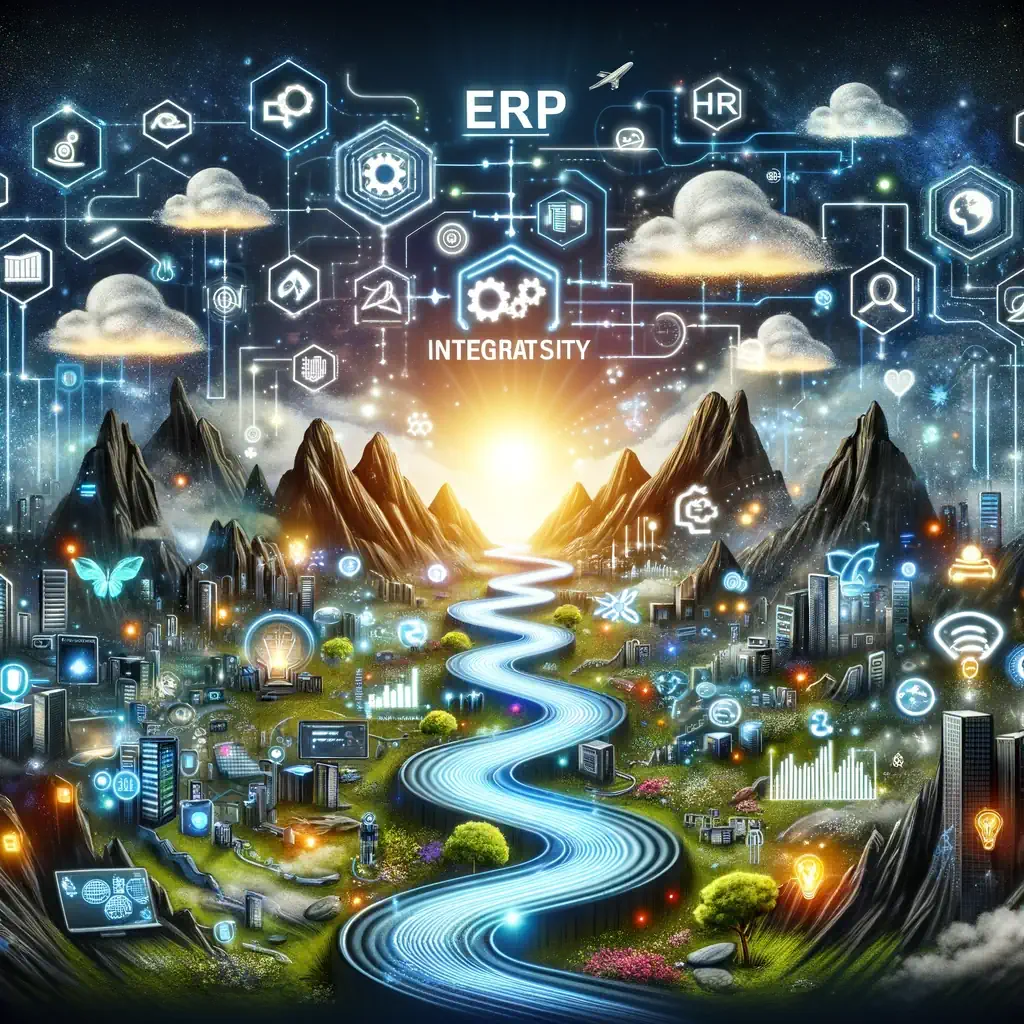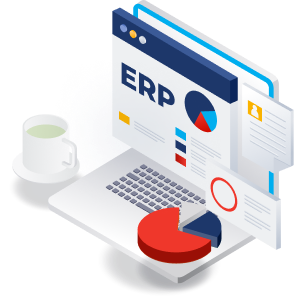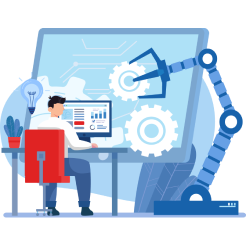
ERP System Integration Challenges: Managing Complexities of Modern Business Technology
Embarking on the ERP Integration Journey: Unraveling the Complexities for Business Success

Welcome to the world of ERP (Enterprise Resource Planning) integration – a journey filled with complexities, innovations, and strategic maneuvers. This article isn't your run-of-the-mill tech guide; it's an exploration into the intricacies of integrating an ERP system into your business fabric. If you're looking to navigate this crucial process with fewer hitches and more confidence, then you're in the right place.
If ERP is one application for the entire business, why I need integrations?
- To put simply, ERP tries to be one thing for everyone, but if you want to boost your efficience to the sky, then you may need integration with something, that specifically manages some area. Let's start from trivial example, and compare the phone vs camera. Couple of years ago, I'd say decades ago, photo quality of the phone vs photo quality of the camera was by no means comparison. But with the progress of time, camera of the expensive phone performs better, then cheap camera. The same holds true about software. Highly specialized software for HR, HCM ( Human Capital Management ), Payroll, WMS ( warehouse management system ), especially if it targets specific industry, may outperform one size fits it all ERP. In order to get the best of both words integrations exist. There are integrations, which are trivial, like export into excel from HCM, and then import into ERP. And there are bi-directional integrations, when clicking of the checkbox in ERP, triggers the same or similar checkbox or even checkboxes in WMS. And the opposite, action in Payroll module triggers changes in ERP in the matter of seconds or even miliseconds. Depends from architecture. Want to mention, that Acumatica ERP supports bi-directional syncronization: from outside system to ERP ( as REST API call ), and from ERP to outside system as webhook.
Charting the Course: The Intricacies of ERP Integration
- Why are API Integration, cloud-based solution and ERP Applications Crucial for Modern Businesses of All Sizes?
- What Challenges Arise During ERP System Integration?
- Legacy Systems and Integrated ERP: A Complex Relationship?
- The Planning Paradox: How Crucial Is It for ERP Success?
- Tackling the Challenges: Are the Obstacles in an ERP integration project Insurmountable?
- The Ripple Effect of ERP on Business Operations
- Software Integration: The Key to a Unified ERP System?
- Integration Platforms: The Silent Heroes in overcoming ERP integration challenges?
- The Shift to Cloud-Based ERP: A New Era?
- Toolbox for Success: Essential Tools for ERP Integration
Why Is ERP Integration Crucial for Modern Businesses?
In today's fast-paced business environment, ERP integration isn't just about technology; it's about survival and leveraging the benefits of ERP. By connecting disparate systems and streamlining processes, ERP integration fosters a synergy that drives efficiency, enhances data accuracy, and boosts overall business performance. It's similar to creating a complex tapestry where each thread – finance, HR, operations – merges through point-to-point integration to form a coherent and functional masterpiece.
What Challenges Arise During ERP System Integration?
Embarking on an ERP integration project often feels like navigating a maze with unexpected twists and turns. Businesses commonly face hurdles such as data inconsistency, system compatibility issues, and the daunting task of aligning various business processes. Every challenge is a puzzle piece that requires an integration solution and strategy to fit into the bigger picture of your business's operational needs.
Legacy Systems and Integrated ERP: A Complex Relationship?
Integrating legacy systems with new ERP solutions is akin to blending traditional wisdom with modern innovation. These systems, deeply embedded in an organization's history, often resist the new digital wave. The key lies in finding a balance – upgrading them enough to sync with modern ERP solutions without losing their inherent value.
The Planning Paradox: How Crucial Is It for ERP Success?
Diving into ERP integration without a roadmap is like sailing without a compass, a common reason why ERP implementations fail. A strategic plan acts as a guiding star through the complex process, helping to anticipate and mitigate potential challenges. However, flexibility is crucial; the plan must evolve as the journey unfolds, adapting to unexpected scenarios and discoveries.
Tackling the Challenges: Are They Insurmountable?
While the integration challenges of ERP implementation can seem daunting, they're not insurmountable. With the right approach, tools, and mindset, these obstacles become opportunities for growth and learning to overcome ERP integration challenges. It's about turning the tide in your favor, using each challenge as a stepping stone towards a more integrated, efficient business system.
The Ripple Effect of ERP on Business Operations
The implementation of an ERP system reverberates throughout all aspects of a business. It's not just about improving individual operations; it's about transforming the entire organizational workflow. From enhanced decision-making capabilities to streamlined processes and improved data management, the ripple effect of ERP integration touches every corner of a business.
Software Integration: The Key to a Unified ERP System?
Incorporating different software systems into a unified ERP solution is like conducting an orchestra – each instrument (or software) must play in harmony. The integration project is crucial for ensuring seamless API integration and data flow between various business functions. It's a delicate balance, requiring both technical acumen and an understanding of how each system contributes to the overall business objectives.
Integration Platforms: The Silent Heroes?
Integration platforms play a crucial, albeit often understated, role in ERP integration. They act as the glue that holds the diverse components of an ERP system together, ensuring seamless communication and data transfer. These platforms, like common ERP applications, are like the backstage crew in a theater production, essential yet often out of the spotlight, making sure everything runs smoothly and efficiently.
The Shift to Cloud-Based ERP: A New Era?
The migration towards cloud-based ERP systems marks a significant shift in the business technology landscape. This move offers unprecedented flexibility, scalability, and accessibility. Imagine having your entire business process available anytime, anywhere – that's the power of cloud ERP. It's like upgrading from a static, on-premises setup to a dynamic, globally accessible network.
Toolbox for Success: Essential Tools for ERP Integration
Navigating the ERP integration process requires a well-equipped toolbox. From data migration tools to integration software, each tool plays a crucial role in ensuring a smooth transition. Selecting the right tools is like choosing the right gear for a hiking expedition – they can make the journey less arduous and more successful.
Navigating Uncharted Waters
ERP Integration is Crucial for Business Evolution: Staying competitive and efficient in a dynamic market, especially for businesses of all sizes, is tied to the effective use of ERP applications.
Integration Challenges are Part of the Journey in ERP Implementation.: Each obstacle in ERP integration offers a chance to learn and grow.
Legacy Systems Need a Balanced Approach When Integrating New Application.: Upgrade them to blend in with new technologies while preserving their core functions.
- Strategic Planning Guides the Way: It's essential but must remain adaptable to changing circumstances.
- Challenges are Opportunities in Disguise: With the right mindset, obstacles can be transformed into stepping stones for success.
ERP Has a Far-Reaching ImpactIt transforms every aspect of business operations, particularly with challenges and strategy to data integration.
Software Integration is Key in connecting the ERP and driving business agility.: Ensuring harmony among different systems is crucial for a unified ERP environment. Hence, a successful integration project is critical.
Integration Platforms Play a Critical Role in Application Integration.: ERP Systems have become essential for seamless communication and data flow.
Cloud-Based Integrated ERP Opened New Possibilities for Fulfilling Business Needs.: ERP software brings flexibility, global accessibility, and addresses common challenges.
Choosing the Right Tools, Like Business Intelligence, is Vital in Traditional ERP.: They determine the efficiency and success of the integration process.
Sailing into Uncharted Territory: Advanced ERP Integration Strategies
Continuing our ERP integration journey, let's delve deeper into advanced strategies, the human aspect of integration, and measuring success. This part of the voyage is about fine-tuning our approach and ensuring that the integration not only fits our current needs but also paves the way for future growth and adaptation.
Advanced Strategies: Beyond the Basics
ERP Integration and the Art of Customization: Every business is unique, and so should be its ERP system. Customizing your ERP not just in terms of software but also in aligning it with your specific business processes is crucial. It’s like tailoring a suit – it needs to fit your business perfectly.
Integration Beyond the System: Third-Party Apps, ERP Applications and the Challenges of API Integration.: In today's interconnected world, your ERP system doesn’t operate in a vacuum. Integrating third-party applications to your ERP software can extend its capabilities, much like adding specialized tools to your toolkit. This might include CRM systems, e-commerce platforms, or industry-specific solutions.
The Continuous Evolution: ERP System Upgrades and Scalability: An ERP system is not a one-time investment but a continuously evolving element of your business. Regular updates and scalability considerations ensure that your ERP software grows with your business, adapting to new challenges and opportunities.
The Human Element: Training and Adoption
Training: A Critical Component of ERP Success: Integrating a new ERP system is as much about technology as it is about people. Effective training programs are essential for ensuring that your team can make the most of the new system. It’s like teaching your crew to navigate new waters – essential for a smooth journey.
Overcoming Resistance to Change: Change is often met with resistance. Addressing concerns, involving team members in the process, and demonstrating the benefits of the new ERP system are key strategies to facilitate adoption. It’s about turning skeptics into advocates.
Measuring Success: How to Tell if Your ERP Integration is Working
Key Performance Indicators (KPIs): The Metrics That Matter: How do you know if your ERP integration is a success? By measuring its impact. KPIs such as operational efficiency, data integration accuracy, and financial performance offer tangible metrics to assess the effectiveness of your management software.
Feedback Loops: Listening to Your Team and System Users for ERP integration needs: Sometimes, the most valuable insights come from those who use the ERP software daily and understand the benefits of ERP integration. Regular feedback from your team can highlight areas of success and those needing improvement, providing a roadmap for ongoing refinement of the ERP system.
Looking Ahead: Future-Proofing Your ERP System
Staying Agile in a Changing Business Landscape: The only constant in business is change. An ERP system should not only address current needs but also have the agility to adapt to future challenges and opportunities. This means staying informed about technological advancements and evolving business practices.
Integrating New Technologies in Your ERP Software.As new technologies emerge, integrating them into your current ERP system leveraging ERP software integration can provide your business a competitive advantage. This might include AI, machine learning, or blockchain, each offering new ways to enhance efficiency and decision-making.
The Role of Leadership in ERP Integration
Leading by Example in ERP Software Integration: Successful ERP integration, a key to business agility, often comes down to effective leadership. Leaders need to champion the ERP integration solution project, demonstrate their commitment, and ensure alignment with the organization’s strategic and operational goals.
Building a Culture of Continuous ImprovementAn ERP system, supported by a reliable ERP vendor, is not just a tool but part of your business culture and an essential component of your organization's data integration strategy, unlocking the benefits of ERP. Cultivating a culture of continuous improvement, where regular updates and adaptations are the norms, can maximize the long-term benefits of your ERP system.
In Conclusion: The End of One Journey, The Start of Another
ERP Implementation is a Dynamic Process and a Solution to Integration Challenges.: It's an ongoing journey of adaptation and improvement.
- The Importance of Customization and Scalability: Your ERP system should grow and evolve with your business.
People Are Key in Managing Common Challenges in ERP Implementation.: Effective training and change management are crucial for success.
Success in Project Management is Measurable through ERP Implementation.: Use KPIs and feedback to gauge the effectiveness of your ERP integration.
Stay Agile and Open to New Technologies and ERP Integration Solutions: Be ready to incorporate new advancements like cloud-based solutions to keep your ERP system at the cutting edge.
- Leadership Drives ERP Success: Strong leadership is essential for guiding your organization through the integration process and beyond.
As our ERP integration journey concludes, remember that this is just the beginning of a longer adventure. With the right approach, tools, and mindset, your ERP system becomes more than a software solution – it transforms into a strategic asset that propels your business forward. In the ever-changing seas of business technology, staying agile, continuously learning, and adapting are key to navigating successfully. Embrace this journey of ERP implementation not just as a challenge to overcome but as an opportunity to redefine and enhance how your business operates and thrives in the modern world.
Embarking on an ERP integration journey is a complex but rewarding venture. It requires a combination of strategic planning, adaptability, and the right set of tools. By understanding the Traditional ERP integration challenges can be formidable, especially when bringing in a new application into an existing system. and embracing the opportunities they present, businesses can navigate the ERP implementation process successfully and reap the benefits of a unified, efficient system. Remember, it's not just about the destination; it's about the journey and the transformations that occur along the way.
In case, if you are looking for reliable Cloud ERP partner, then think no further, AcuPower LTD has 40 proffesionals, who will be more then happy to be your guides, team and partners in suchlike journey!
Frequently Asked Questions (FAQ)
What is ERP integration?
ERP integration ERP integration refers to the process of connecting various applications within an organization to the cloud-based solution. ERP system, allowing seamless data flow and coordination between different functions and departments.
What are the challenges of ERP integration?
ERP integration challenges include data integration, application integration, legacy system migration, and project management complexities. Organizations face hurdles in aligning business processes and managing software integration.
How does ERP software integration benefit business processes?
ERP software integration streamlines business processes by providing a unified platform for managing various functions such as finance, human resources, inventory, and customer relationship management. This enhances efficiency and data consistency across the organization.
What is an ERP system?
An ERP system is an integrated suite of applications used to manage core business functions such as finance, human resources, procurement, and supply chain. It enables organizations to centralize data and streamline processes.
What are the key elements of successful ERP integration?
Successful ERP integration ERP integration requires a well-defined strategy, robust cloud-based solution, integration solution, effective project management, and alignment with business needs. Overcoming common challenges and ensuring data consistency are vital for a successful implementation.
How can organizations overcome the challenges of integrating ERP systems?
Organizations can overcome challenges by leveraging cloud-based ERP, adopting a comprehensive integration strategy, embracing the benefits of ERP integration, cloud ERP Automate business solutions, and choosing the right cloud-based ERP system. ERP vendor Deciding on an ERP system that aligns with their specific business needs.
What are the benefits of implementing an ERP system?
Implementing an ERP system brings significant benefits, including improved operational efficiency, enhanced decision-making through real-time insights, streamlined business processes, and better management of resources and projects.
What is the importance of data integration in ERP?
Purpose of all integrations is to have single source of truth. Placed in some or the other form of Database.
Comments (0)
No comments yet
Be the first to comment
 Share on Facebook
Share on Facebook
 Share on LinkedIn
Share on LinkedIn
 Share on Twitter
Share on Twitter


 1463
1463

